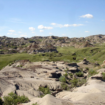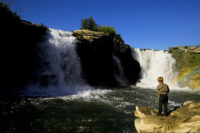Rattlesnake sightings expected to increase with warmer weather
By Lethbridge Herald on May 2, 2024.
 A rattlesnake hides in the grass in a coulee along the city’s river valley. Residents are reminded to be aware of their surroundings as snakes will moving away from their dens as temperatures begin to warm up.THE CANADIAN PRESS FILE PHOTO/Jeff McIntosh
A rattlesnake hides in the grass in a coulee along the city’s river valley. Residents are reminded to be aware of their surroundings as snakes will moving away from their dens as temperatures begin to warm up.THE CANADIAN PRESS FILE PHOTO/Jeff McIntoshDelon Shurtz – LETHBRIDGE HERALD – dshurtz@lethbridgeherald.com
With warmer weather approaching and increasing numbers of people heading to parks in the river valley, the city’s senior bylaw officer offers a little advice: remember this is snake country.
Rattlesnakes are becoming active in the coulees and river bottom, and even though it’s still a little too cold for them to be out in any significant numbers, or for very long at one time, sightings will increase as the temperature becomes consistently warmer.
Dave Henley says rattlesnakes are slowly making their way out of their dens, but it’s still a little early in the year for them to be moving around too much.
“They’ll be moving away from the den sites as soon as the weather warms up to a consistent above-zero range, like five and 10 degrees overnight,” Henley says.
He says snakes still need to be near their dens for protection from the cold nights, but residents can expect them to be out and about soon.
“It’s really dependent upon the type of spring we have, how fast and how far they start moving.”
When the temperature becomes really hot, residents can expect to see snakes in the morning and evening. During the hottest times of the day snakes tend to seek shade and won’t be as visible. That’s also when residents need to be cautious and avoid areas where snakes may be hidden.
Henley advises residents living near the coulees and people hiking among them or visiting parks in the river valley to simply be aware of their surroundings. The snakes, he points out, are not aggressive and prefer avoiding humans, but it’s easy to come upon one by accident, especially since they are camouflaged to their surroundings and are hard to see.
That’s why Henley advises people to listen as well as look.
“Whether you’re on a paved path or a natural pathway, you need to kind of pay attention, and not just look, but listen. The rattlesnake’s warning is very distinct. Their natural defence mechanism is to shake that tail. If you do hear that, just take a second and stop and look around you, and see if you can locate the snake.”
Henley suggests taking a wider look around, as well, to avoid any other snakes that may be nearby.
“They’re not aggressive. The snakes do not see humans as any sort of prey. The only time they’ll react is in self defence. You’ve got to be real careful because you don’t want to step on them. Where you’ll get a reaction is if you step directly on the snake.”
For residents who live near the coulees, it’s also important to be careful when gardening or collecting wood from the woodpile.
“It’s really important to be aware and don’t just stick your hand in somewhere to get something. You don’t want to reach your hand into a hole or an area where there may be a snake.”
It may all sound kind of scary, but Henley says snake bites are rare. Pets are more likely to be bitten, which is why pet owners need to make sure their dogs are on a leash when walking in or near the coulees, and not just because of the snakes. The coulees are brimming with all sort of wildlife that can pose a threat for people walking their dogs.
If bitten by a snake, Henley advises remaining calm, staying still – just make sure the snake is gone – and calling EMS.
Snakes, including the nonvenomous bull snake and garter snake, can be found just about anywhere in the coulees and river bottom, as well as on top of the coulees on the prairies. That means they may be encountered in numerous residential neighbourhoods, although predominantly in southwest Lethbridge in Paradise Canyon and RiverStone. They’ve been seen in Copperwood, however, and they’re on the east side of the river, as well, although in fewer numbers.
Henley says the city received nearly 160 calls last year to relocate rattlesnakes, which typically involves trapping them and moving them closer to the nearest den. But not all snake sightings require relocation.
“If people need a snake relocated they can call us, but if a snake is in a natural area like along a coulee pathway or something like that, they’ll just kind of move on. That is their natural habitat.”
Additional information about rattlesnakes can be found on the city’s website, and anyone who believes a snake should be relocated can call 403-332-6806.
22-21




